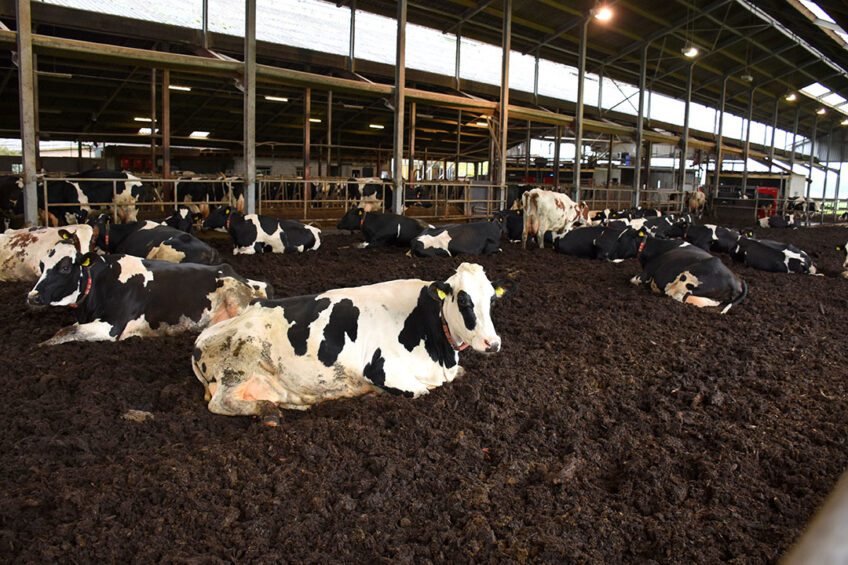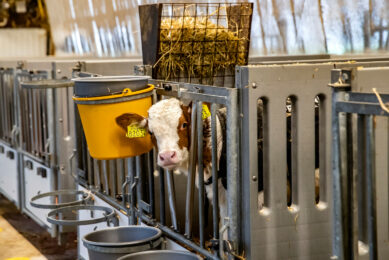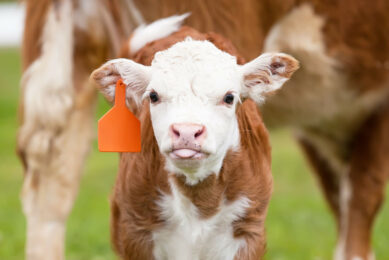Dutch dairy farm: Benefits of woodchip bedding

Using woodchip as a bedding material in a loose pen for older and fresh calved cows is proving a real success on a Dutch dairy farm where even the used material has a recycle value.
Wim Lubbersen milks 190 cows on the family farm near Holten in the east of the Netherlands with his twin sons Kevin and Twan.
The cows are kept indoors all year round on the farm which extends to 100 hectares split into 70 hectares of grass and the remainder in maize.
Three Lely A3 robotic milking units milk the cows an average of 2.9 times per cow per day resulting in an average yield per head of 11,000kgs on 305 days at 3.65% protein and 4.45% butterfat quality. The family supply their milk to Friesland Campina and receive a base milk price of 35 euro cents per litre.
Four years ago Wim installed the Lely Vector automatic feeding system and formulated a mix of grass silage, maize, concentrates and water fed at 40 percent dry matter to his cows.
The Vector travels along a pre-designed route via sensors to push up the feed in the passage and add fresh material where and when it is required.
In total, the feeder makes 15 trips per day along the passage dispensing enough feed to give the cows an intake of 22kgs of dry matter per head per day.
“We top up the feed station three times per week,” said Wim. “The Vector feeding system costs us only 3 per day for electricity which we feel is very reasonable,” he said.

Slurry production
The main dairy herd resides at the home farm but the young stock are all kept at a different location just 2km away where they remain until calving time at 24 months. Cows stay in t€he main herd for an average of three lactations.
All the heifer calves eventually join the main herd as replacements and any bull calves are sold for €50 each at 14 days old to other farmers for fattening or veal production.
As you can imagine with a herd this size kept indoors all the time there is a lot of slurry and manure that accumulates each month. All the slurry is separated into solids and liquid and there is a big demand for some of it off farm.
“We separate all our slurry and later inject the resulting liquid directly into the ground,” said Kevin. “The solids become a compost like material and is applied to our land dedicated for growing the maize each year.
“It also goes to fellow farmers in the local area for their fields as it is a really good fertiliser for them as well,” he said.

Dairy farmers in the Netherlands are subject to many regulations, particularly regarding emissions, with phosphates and nitrates the main offenders.
“We have sold cows recently so that we confirm to our phosphates quota,” said Wim. “One cow produces around 45kg of phosphates per year and the quota costs around €8,000 per cow to purchase.
These emission regulations are proving very controversial in the Netherlands and other European countries with many different convoys of tractors taking to the roads and blocking major cities in protest.
To try and keep the emissions as low as possible the Lubbersens have built a large open pen for their aged cows and freshly calved animals. One area of around 75m by 14m is bedded and there is a further area of 75m by 4m that is in concrete used as feeding space.
Woodchip
The bedded area is filled with woodchip produced in the local area to a depth of 70cm. Suction pumps withdraw moisture from the bedding to keep it drier and the resulting composting woodchips stay at a temperature of around 30˚C.
Kevin said: “Our shed is filled with woodchips produced from our local district. The total cost of filling it is about the same as a regular cubicle shed as the woodchip is less than €30 per tonne.
“The bedding area is around 15 square metres each per cow. The bedding is 70cm deep with a suction plant sucking the moisture out via a small hole every square metre.
“A lot of moisture evaporates through composting and nitrogen is bound by the soil material. We rotavate the bedding once per day.
“Around 60 cows are kept in this bedded pen at any one time and we use one of our milking robots specifically for these animals,” added Kevin.
“We change the whole bedding once a year, and in the winter we refresh the bedding every two weeks with a layer of fresh woodchips.
“In the spring we spread the bedding on our corn fields as it is an ideal fertiliser,” he added.
Join 13,000+ subscribers
Subscribe to our newsletter to stay updated about all the need-to-know content in the dairy sector, two times a week.










